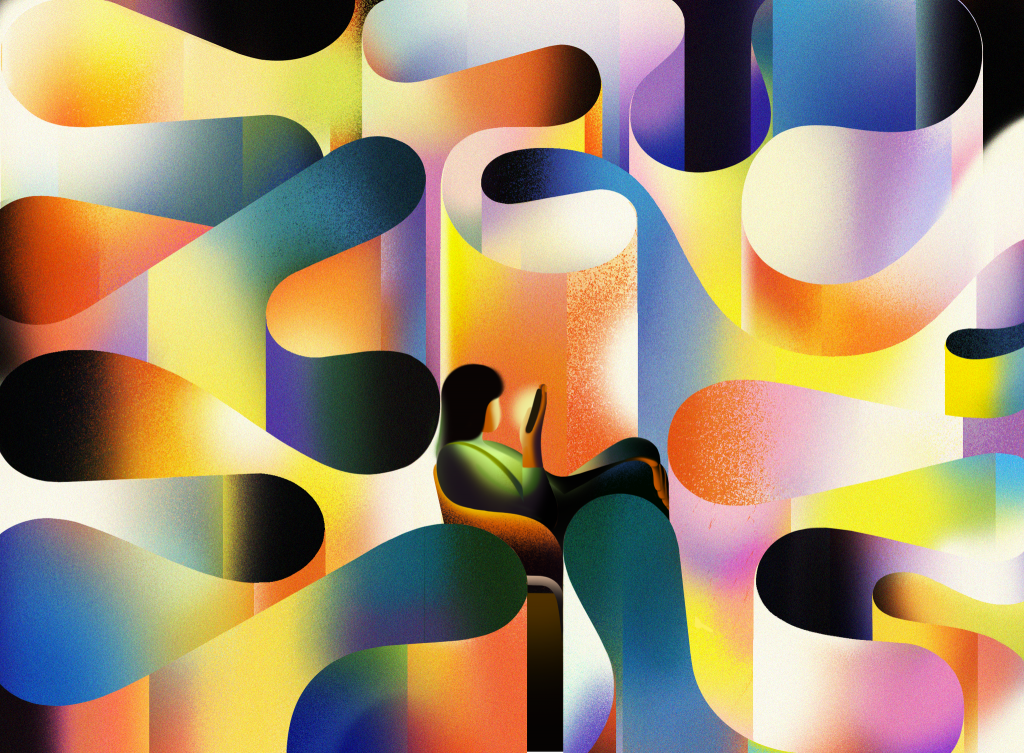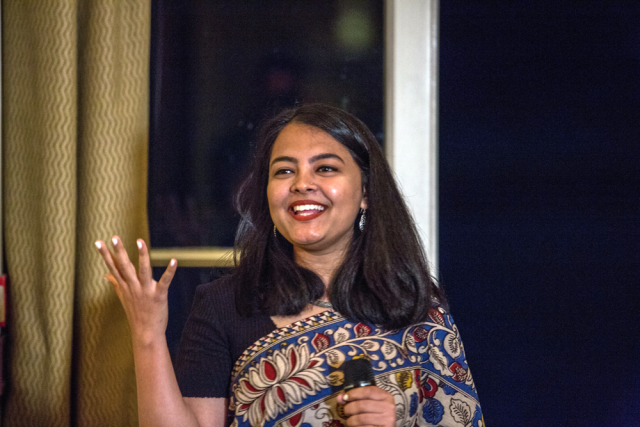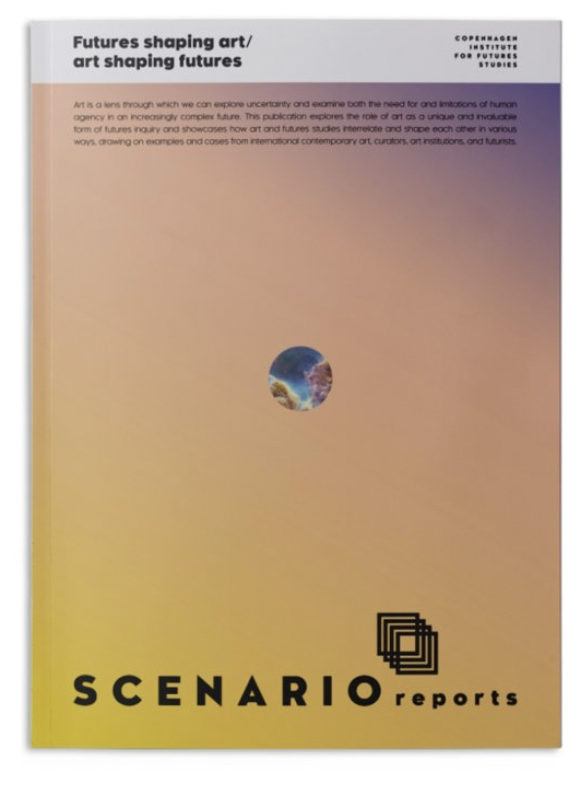What do the worlds of art and design and futures studies have in common? Both can open our minds to alternative futures. As humans we are constantly evolving and working towards the future, we know that there are so many alternative futures and predictions about it. We can draw insights on what the future will entail from what we know about new developments in all aspects of consumerism, data, and the spirit of the times.
Depending on where you live, it could positively or negatively impact your idea of potential futures, and the different narratives across the globe makes it hard to truly grasp any idea of where we are moving as a society. Or if marginalised groups of people are even considered or sitting at the table making decisions about a potential future that could affect all of us. Future studies and digital design are moving closer together, but it’s still a little unclear on how they complement each other.
To tell us more about how futures studies and art and design can come together and complement each other, we talked to Nicklas Larsen from the Copenhagen Institute for Futures Studies (CIFS), a danish non-profit futures think tank.

As a senior advisor at CIFS, Nicklas is responsible for happenings, collaborations, and partnerships with educational institutions like UNESCO and Denmark’s National School of Performing Arts.
There are many inspiring facets to Nick, but what I was most inspired by was his passion for bringing futures studies to students. He is working with a variety of educational institutions across business, design and art, because he believes that we need to include everyone in the creation of our shared future.
“Students are incredible. They possess an outlook, energy and creativity beyond their parents that often operate and think within the confining structures of an organisation. As we grow up it seems like we forget the innocence and childish, and playful ways of approaching uncertainty. That’s why I find purpose in introducing anticipation and futures thinking early, for individuals to nurture that kind of capability from early on.”
Words From Nick

How can digital design and futures studies come together to help us understand the complexities of the world? How do they complement each other?
It’s a really good question because the answer depends on vantage points. Perhaps a designer will disagree when I say this. From a futures studies perspective, I think the discipline seeks to open up, bend minds, reveal and challenge assumptions to widen the horizon by asking questions, and that the design practice seeks answers to those questions towards prototyping. On the contrary, design can respond to present needs, desires and behaviour, to then extrapolate and explore how these might look or need to be adapted for the future.
In any case, the disciplines sync in their similar approach to divergence and convergence mechanisms, and many studies actually point to how the disciplines feed and enhance each other from the anticipatory to the tangible or the other way around. They have even merged together and formed a form of hybrid with the best of both worlds called futures design.

How is digital design and the future moving closer together?
From a traditional perspective design was understood as something tangible, physical. While traditional modelling techniques are vulnerable to minor changes in underlying assumptions and are not sufficient to deal with volatile and unpredictable environments, the emergence of digital design, has made the practice become much more flexible and real time, and concepts like spatial computing, designing for disassembly and spatial designs that represents developments in the design practice that moves us closer to perceived futures
What are some fundamental things about futures studies to think about when sharpening your toolbox, if you’re creating, innovating, and acting in the digital world?
Futures and foresight most often applies qualitative, exploratory, and narrative tools to aid decision-makers in expanding their worldview and recognising a range of possible and plausible outcomes, which can be further tested and developed to suit a certain environment. Designers can use these ways as sources of inspiration and to probe, and test prototypes toward possible future outcomes.
Speaking of fundamental things, both designing and futuring are quite value driven and privileged lines of work, in my opinion, and the practises should favour the many rather than the few. While a lot of barriers have been broken down and access has been gained through digitalisation, designing for the future, it is, more than ever, really necessary to remember to raise the long term planetary and human aspects. Who is using these designs, for what purpose and what problem do they alleviate?
We have passed the point of designing for consumption and should focus more on designing for the future by providing guidance and ease towards ethical and mindful choices and behaviour.
Words from Nick


In the Scenario Report for 2021, Futures shaping art/ art shaping futures you wrote an article about Immersive Design which highlighted the new design-driven approach to futures studies, experiential futures. Could you shine some light on this design-driven approach and how it coincides with immersive design and art?
A new design-driven approach to futures studies, experiential futures, takes the discipline out of its oft-written form, and embeds it in immersive art and design driven experiences. This hybrid approach to futures, which was pioneered by the futurist Dr. Stuart Candy, is designed to help us attain a fuller view of scenarios ahead of us by merging the analytical with tangible participatory experiences. In Candy’s words, the goal of experiential futures is to create ‘situations and stuff from the future to catalyse insight and change’. This can take many forms, including performances, exhibitions, the design of ‘speculative artifacts’, games, multi-media productions, or interventions in the public sphere.
Whose someone to keep an eye on when it comes to digital design and future thinking?

Stuart Candy, as mentioned, for his ever-inspiring take on futures studies, and for enhancing the discipline with a theoretical standpoint for bringing futures to life from design approach.

Pupul Bisht, a multi-disciplinary designer and futurist, who founded the decolonising futures initiative partly to challenge the westernly dominated approach to futures and design methodology.

Kaave Pour, founder of innovation and design lab, Space10, who was the first to introduce me to the idea that human centered design should be a thing of the past.
In 2019 we interviewed Kaave
Click here to read the article
Lastly, I find the work of SynergyXR really interesting. Actually, the whole aspect of the digital realm, and the emergence of the metaverse are indeed captivating with corporations, people and governments already buying up land or stuff in the metaverse. But while we’re excited, we have to ask ourselves – is it an elitist dream or a world of possibility?
In any case, the mind wanders, and asks: Who is the guardian of: equal access, inclusion, safety and the new norms that comes with the new internet 3.0? A lot of my concern about the metaverse has to do with how to limit bad behaviour online. It must be mandatory for the designers of the metaverse to make it a safe space for everyone.

The future feels lacklustre and bleak when you realize that not everyone’s perspectives, experiences, or disposition is included in this narrative we are painting about inclusion and diversity in the global north. It can be thought from a new perspective when we use art, culture, and design to communicate the stories of the future, without the following we would never be able to imagine beyond our wildest dreams.
As we move on as a society, design which was once a practice focusing on tangible problem solutions has transformed into designing for digital spaces. We’ve learned from quarantine that the neuroaesthetics of a physical space can affect you, but how can we take the same principles and apply them to designing for digital spaces. Future studies can provide fundamental tools for digital designers to incorporate in their practices.
I was left with some final thoughts from speaking to Nick. How do we stray away from designing strictly for indulgences and consumption? Circular and universal design seem to be new topics that designers are working towards which may help answer this question. The sentiment behind most digital designers today is how do we get away from thinking solely from problem solutions from a design approach? There is still so much to be discovered and I think it’s important not to downplay the power of art, culture, and design.
Cover Photo: Team Lab Tokyo











